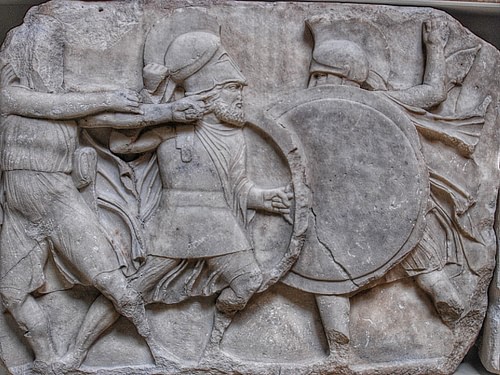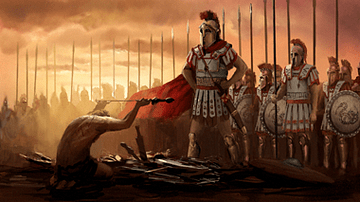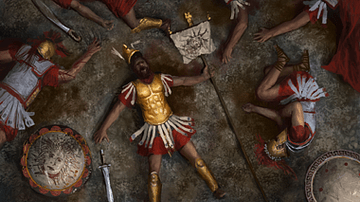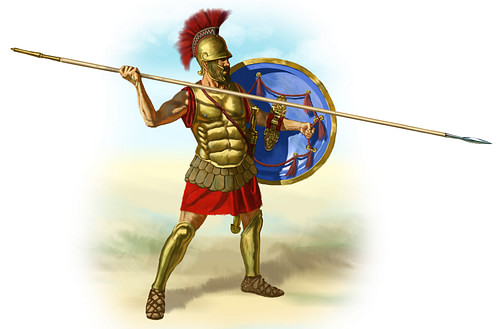
A Hoplite (from ta hopla meaning tool or equipment) was the most common type of heavily armed foot-soldier in ancient Greece from the 7th to 4th centuries BCE, and most ordinary citizens of Greek city-states with sufficient means were expected to equip and make themselves available for the role when necessary.
Athens had a system of compulsory military service for 18-20-year-olds, but during a war, all male citizens up to the age of 60 could be called up to the armed forces. Other cities across ancient Greece followed a similar policy which meant that hoplites were not professional soldiers and often lacked sufficient military training, although some states did maintain a small elite professional unit, the epilektoi. The most famous of these was the Sacred Band of Thebes, a unit composed of 150 pairs of male lovers who swore to defend their partner to the death. Sparta, where all male citizens over 20 were members of a permanent professional army, was the notable exception to this approach of only calling up an army when absolutely needed and, consequently, their hoplites were famed for their military prowess.
Weapons & Armour
The principal weapons of a hoplite infantryman were a long ash wood spear (doru) and a short sword (xiphos). The spear measured on average 2.5 metres (8 ft.) in length and was fitted with a bronze or iron blade and a four-sided end spike (sauroter). The sword was also of iron with a straight or sometimes curved blade (machaira or kopis) no more than 60 cm in length. No doubt many hoplites also carried a dagger (encheiridion) as extra insurance. Protection was provided by a leather-lined bronze helmet which could vary in design, was often crested, and protected the head, neck, and face. A corselet or breastplate (thorax) of bronze or leather (later reduced to a laminated linen vest to save weight - a linothorax), bronze greaves (knemides) to protect the shins, and sometimes arm-guards were also worn. The hoplite carried a large circular shield (hoplon or aspis) some 80 cm (30 in.) in diameter and weighing as much as 8 kg. This was made of wood or stiff leather, faced with bronze, and was held with the left arm placed through a central band (porpax) and gripped via a strap (antilabe) attached to the shield rim. Shields often carried particular designs - the most famous being the inverted V-shape of Spartan hoplites - and emblems - particularly popular was the gorgon from Greek mythology with its association with changing the onlooker into stone. Surviving examples of breastplates and helmets also display engraved decoration. Fully armoured then, the hoplite was required to carry some 20 kg of equipment and so good physical training must have given one side a strong advantage (e.g. the well-trained and professional Spartans). Precisely because all of this equipment amounted to quite an investment, being a hoplite also indicated that the individual had a certain status in wider Greek society. In addition, the bronze cuirass and shield of the hoplite - taken, for example, as booty after a military campaign - were often dedicated at sacred sites across ancient Greece from Delphi to Delos.
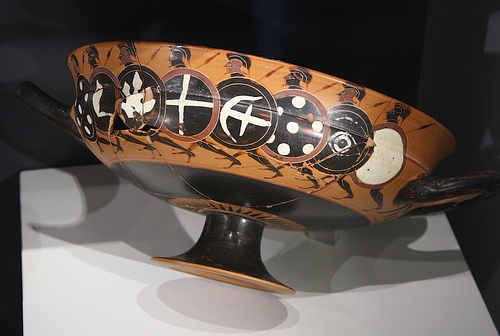
Hoplite Phalanx
Hoplites were organised into regiments or lokhoi (several hundred men strong), and they fought in ranks eight or more men deep (known as a phalanx), and standing close together, half of the shield of one man protected his neighbour on his left side. This, interestingly, meant that the phalanx often moved forward at a slight angle to the right as men sought to keep behind the shield of their neighbour. This resulted in the left flank usually breaking formation first, and so this was the flank a competent commander would attack with priority, and he would, therefore, ensure he had his best troops on his own right flank. The Greek phalanx advanced at a walk or faster, often accompanied by rhythmic music from aulos players, and shouting a tremendous war-cry (paean). On engaging the enemy the hoplites first thrust their spears, usually overarm. After that initial contact, the opposing lines usually went through a series of pushing and shoving (othismos) and close-quarter fighting with swords which only ended when one side broke ranks. The pursuit of retreating hoplites was usually only over a short distance in order to maintain the protective close formation.
Hoplites were instrumental in Greek warfare and the victories of Greek armies over Persia at the battle of Marathon (490 BCE) and the battle of Plataea (479 BCE) during the Greco-Persian Wars. The weaknesses of the phalanx formation - attack from the flanks, rear by light cavalry, or when on rough terrain - were sometimes exploited by more wily commanders; however, the formation, albeit with lighter-armed infantry, was still in use through Hellenistic and early Roman times.

